
by pmdavis | Sep 14, 2023

First meeting is Sept 26th at 5:30 EST
I am so thrilled to let you know about a new endeavor with Florida 4-H. We are trying a virtual Food Challenge cooking club this year. This is so exciting for me because some of my fondest memories are cooking with my grandmother and Mom. I got to learn how to prepare foods and be creative as I was growing up pulling on their apron strings. I also enjoyed teaching and sharing these skills with my own children. What makes this even better is now I get to share and learn with all of you who join our program.
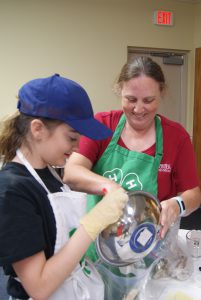
Paula and Madelyn Cooking together
By joining the new Virtual 4-H Food Challenge Club, you will embark on a fun, yet challenging, food-focused adventure right from the comfort of your kitchen! The club adventure will provide a fun atmosphere for you and your children to have a family time experience building lasting memories together. With the help from Florida 4-H Youth Development Faculty, you will get to unleash your culinary creativity and try delicious recipes while learning kitchen skills from safety, nutrition, and other food related life skills. Families will learn about competitive events related to foods like the Florida Food Challenge Competition. Families will also have the opportunity to make friends with fellow 4-H members across the state.
The virtual club is open to youth members ages 8-18 and will meet once a month starting in September. The club will meet via ZOOM on the following Tuesdays: September 26th, October 24th, November 28th, December 19th, and January 23rd from 5:30 – 6:30 PM ET. We request that adult supervision is present with the youth during the meeting and home practice sessions. The participants will be asked to gather a list of supplies for each monthly meeting as we focus on a new skill for each meeting.
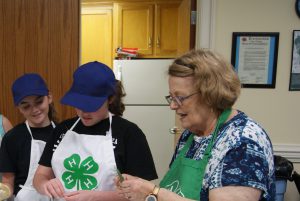
Paula’s family working with herbs to prepare a dish.
During this course we will help families enjoy preparing food, provide you with opportunities to problem solve together and work as a family team as practice preparation for the Florida 4-H Food Challenge! If you join us, your family will learn how to prepare and create yummy dishes with a predetermined set of ingredients. By the end of the program, your family should have some new recipes for your cooking toolbox, learned essential cooking skills and created wonderful memories from your time together. Do not miss this flavorful opportunity – sign up now via Florida 4-H Online and get cooking with 4-H! If you are not a member of a current 4-H Club there is a $20 membership fee associated with this club. If you are unable to join our virtual club, contact your local UF/IFAS Extension office to see if there is an active Food Challenge group that you can join. If not, work with your 4-H or FCS Agent(s) to identify two caring adults who could fill this role.
Enroll, Grab your ingredients, and get ready to join us via Zoom on September 26th@ 5:30 EST
by Rachel Pienta | Jun 12, 2023
Many 4-H clubs take a break during the summer months. Club leaders and youth may travel, have different summer schedules, or choose to participate in camps during the summer months. 4-H volunteers can help play a role in helping youth and families transition to summer activities. Furthermore, the transition from the club year to summer activities is an opportunity for volunteers to help lay a foundation for youth retention in the next 4-H year.
Research shows that summer activities can play an important role in youth development:
Out-of-school and summer programs can play a variety of important roles in supporting healthy development during childhood. First, out-of-school and summer programs provide a setting for children to experience supportive social relationships with both adults and peers, relationships that foster emotional, behavioral, and cognitive development. Second, such programs offer an opportunity for both structured and unstructured play, as well as a child’s choice in activities. This may be particularly important as schools increasingly focus on structured academic learning, even in the early grades (Bassok et al., 2016), and as other societal changes, such as increased parental employment and greater digital engagement decrease opportunities for unstructured play (Yogman et al., 2018).
(Hutton R. & Sepúlveda MJ, 2019)
Club Year Transitions
Club leaders may choose to close out the club year when the school year ends. This ending may involve a celebration, a recognition of achievement, or it may take the form of electronic communication with parents. It is important to close the club experience with an invitation for future 4-H engagement. This engagement may be day or residential camp, the next club year, a 4-H Open House event. Other club leaders may change the meeting schedule or offer different activities during the summer months. Youth may transition to an older age group with the new club year or may choose switch clubs as interests change. The summer months offer opportunities to help youth choose the next step in their 4-H experience. It is helpful to follow up with a club year recap email that includes summer resources and suggestions. Adding in the date of the fall 4-H Open House event and preview information about the next club year can help increase member retention from year to year.
Opportunities for Senior 4-H Youth

4-H youth receive awards recognizing achievements during 4-H University event.
If your county offers summer day camps, your 4-H agent may be able to engage high school age senior 4-H youth as volunteers. The summer volunteer camp counselor experience can play an important role for rising ninth through twelfth graders who are looking to develop valuable workforce skills and experience. An added plus for youth is that 4-H volunteer hours can count toward fulfilling the Bright Futures service hours requirement.
4-H Summer Camps
Your local Extension office likely offers a variety of themed 4-H day camps that focus on life skills. The state 4-H program also offers residential camps. Senior 4-H youth can also attend overnight events such as 4-H Legislature, 4-H University, and 4-H Grilling Camp. Intermediate youth have the option of participating in the iLead weekend. The county 4-H agent can help volunteers become well-versed in the many summer options offered by 4-H that are available for youth locally and around the state.
For more information, contact your local Extension office and bookmark the state 4-H page.
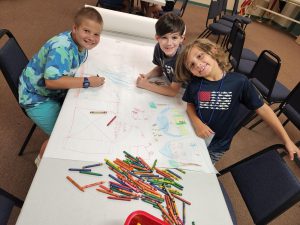
At 4-H summer day camp, youth learn about farms and design their own dream farm.
Resources for Additional Reading
Ellison, S., & Harder, A. (2018). Factors Contributing to the Retention of Senior 4-H Members: From the Youth Perspective. Journal of Human Sciences and Extension, 6(3), 10. DOI: https://doi.org/10.54718/LCJZ7328
Hutton R. & Sepúlveda, MJ, editors. (2019). Shaping Summertime Experiences: Opportunities to Promote Healthy Development and Well-Being for Children and Youth. Washington (DC): National Academies Press (US); 2019 Sep 26. 3, The Effects of Summertime Experiences on Children’s Development. National Academies of Sciences, Engineering, and Medicine; Division of Behavioral and Social Sciences and Education; Board on Children, Youth, and Families; Committee on Summertime Experiences and Child and Adolescent Education, Health, and Safety. Available from: https://www.ncbi.nlm.nih.gov/books/NBK552668/
Lewis, K. M., Hensley, S., Bird, M., Rea-Keywood, J., Miller, J., Kok, C., & Shelstad, N. (2022). Why Youth Leave 4-H After the First Year: A Multistate Study. Journal of Human Sciences and Extension, 10(3), 5. DOI: https://doi.org/10.55533/2325-5226.1429
Newby, L. & Sallee, J. (2016). 4-H Membership Recruitment/Retention Problems: A Meta-Analysis of Possible Causes and Solutions. Journal of Youth Development. 6. 37-46. 10.5195/JYD.2011.163.
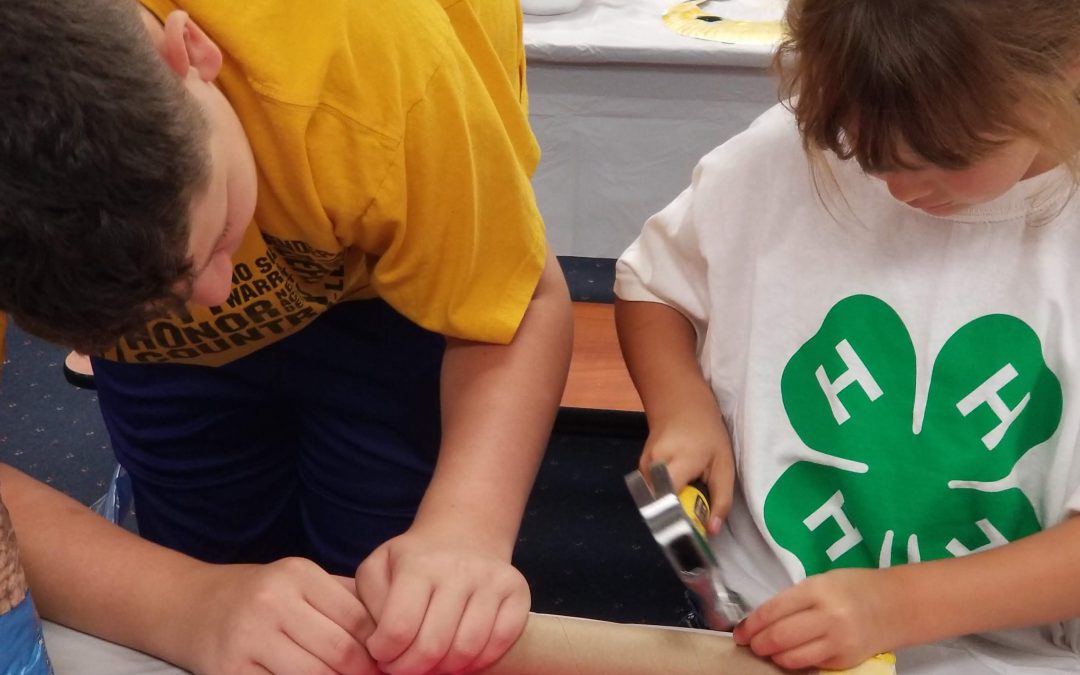
by Niki Crawson | May 19, 2023
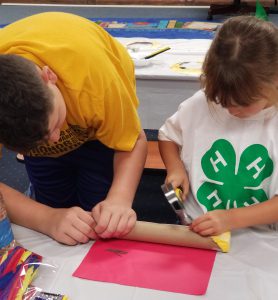
We know that younger youth look up to older youth and like to model their behaviors. We see it in siblings all the time, absorbing behaviors of their older brothers or sisters like sponges. Often times, younger youth find the attention and encouragement of older youth more relatable due to the closeness in age. Peer teaching fosters a more engaging and even symbiotic learning experience as this gives teens the opportunity to share and reinforce their own knowledge. In addition, by pairing the two age groups together in a learning environment, a sense of comradery can develop, creating a greater sense of belonging within the 4-H community. In this post, we will define peer teaching, share a few examples of how to utilize your teens as teachers and provide tips for getting peer teaching started in your clubs and other 4-H events and activities successfully.
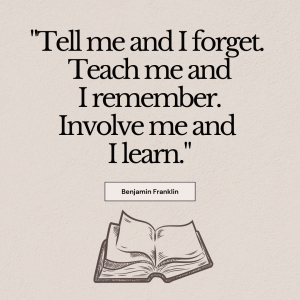
WHAT IS PEER TEACHING?
What do we mean by peer teaching exactly? It is the process of youth learning together and from each other through engaging, hands-on activities. In 4-H, we have the wonderful ability to utilize teens as volunteers and positive role models for our younger youth in our positive youth development programs. Empowering our teens as teachers for our younger members allows life skills to develop among our youth being instructed and also the instructors. The teen instructors are teaching specific topics to their peers at the same time they are strengthening their own leadership, communication, and social skills.
WHAT ARE THE BENEFITS OF PEER TEACHING?
As stated previously, one of the greatest outcomes is that the teacher and the student both gain knowledge and skills. It creates a mutually beneficial environment in which all youth can achieve personal growth and development if implemented and managed correctly. In addition, there are many other benefits of peer teaching such as:
- Peers being taught may form a quicker and better connection with teens due to communication, technology and other trends.
- An increase in peer confidence as they may feel more comfortable in asking questions, discussing topics with others closer to their age.
- Greater creativity as teens may have more innovative or modern ideas to bring to the activities.
- An increase in volunteers as teens have the ability to recruit more teens easier than typical adult volunteers.
- An increase in retention of youth as peers stay in the program and become the next generation of teen volunteers/teachers.
WHAT DOES PEER TEACHING LOOK LIKE IN 4-H?
Below are just a few programs for teens to practice the method of peer teaching in their 4-H county:
- New Members – When new youth join 4-H, it can be overwhelming at times to learn some of the 4-H activities, customs, and such. This would be a great opportunity for
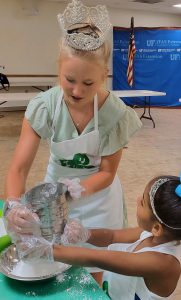 peer teaching. Have teens assigned to new members that join in order to teach them the 4-H pledge, motto, club expectations, member names, etc. This creates a greater sense of belonging and fosters a supportive environment within the club for new members to engage more quickly and successfully.
peer teaching. Have teens assigned to new members that join in order to teach them the 4-H pledge, motto, club expectations, member names, etc. This creates a greater sense of belonging and fosters a supportive environment within the club for new members to engage more quickly and successfully.
- Cloverbud Club Meetings – Utilizing your teen members in club meetings involving Cloverbuds (members ages 5-7) is a great way to incorporate peer teaching in your 4-H program. Younger members thrive off of creativity and enthusiasm which teens often portray easily. Teens can funnel this energy into teaching lessons to Cloverbuds that are engaging and interactive in a simplistic way.
- Summer Day Camps – 4-H programs often times need additional volunteers during the summer to assist with the volume of programming and youth participants. Therefore, summer is a great time to recruit teens to become peer teachers. Having teens as peer teachers helps with supervision and instruction while at the same time, allows them to stay involved in 4-H, continue to apply their life skills learned, and help the program teach life skills to other youth in the community.
TIPS TO GET PEER TEACHING STARTED IN YOUR 4-H COUNTY
What does it take to get peer teaching started in your 4-H county? Time and patience to start with. Teaching with teens is an ongoing task and will take a little effort on your part. Below are a few tips to get you started on having teens peer teach in your county:
- Identify programming that would benefit by peer teaching.
- Recruit quality teen teachers.
- Train and support teens as peer teachers.
- Assign teens appropriate roles in the peer teacher process.
- Model appropriate teaching methods in 4-H programs.
- Shadow teens in the role as peer teachers to provide support and guidance.
- Evaluate, provide feedback, and continue professional development for continued success.
Remember, peer teaching is a great way to utilize teen members in your 4-H programs. Younger youth need as many positive role models as possible in their lives. By having teen teachers take the lead in instruction in your 4-H programs, you are fostering an environment of learning, inclusivity, empowerment, and leadership.
To learn more about 4-H opportunities where teens can take the lead as teachers for their peers, please contact your local UF IFAS County Extension Office, or visit http://florida4h.org.
ADDITIONAL SOURCES:
Burse, G., Crocker, E. T., Jordan, J., McKinney, M., & Murphy, L. (2021). Teens as Teachers 4-H Project: Curriculum and Resources. UF/IFAS Extension, University of Florida. Retrieved May 1, 2023, from https://edis.ifas.ufl.edu/publication/4H432
Eckhoff, A., & Swistock, B. (2011). Staffing with Teenagers and Teens as Cross-Age Teachers. Rutgers Cooperative Extension.
by Marie Arick | Feb 24, 2023

Escambia County’s 1st place Food Challenge Team
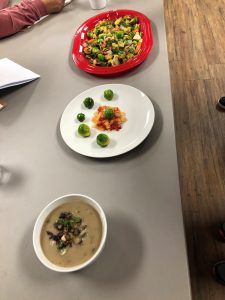
Judging table display of culinary creations. Top, Liberty’s, center Escambia’s intermediate, bottom Escambia’s senior.
The Northwest District 4-H Food Challenge took place on January 7, 2023, and the results were phenomenal! This new competition challenges youth to work as teams of no less than two or more than four, and practice critical thinking, open communication, and presentation skills. Presentations are to include the knowledge and skills youth have learned through the project such as kitchen safety, food safety, cooking techniques, recipe creation, and how they worked together. But that is not all, additionally, teams are using a set of specific cooking supplies, a mystery ingredient, a specific dish category (main dish, side dish, appetizer, or healthy dessert), and a set amount of 4-H money to spend at the challenge grocery store. The entire competition allows 40 minutes for youth to put all of this into practice. Escambia County entered a senior and intermediate team while Liberty County entered an intermediate team into the inaugural competition.
Escambia County’s senior team, dubbed O Crepe and the Spice Girls consisted of Alan Bray-Crews, Laney Clarke, Ryan Clarke, and Aubrie Dillon, who were presented with portabella mushrooms for their mystery ingredient with the category of the main dish. The team produced an excellent mushroom soup as their main dish. The dish along with their well-prepared presentation earned them a place in the Florida 4-H State Food Challenge competition at the Florida State Fair in Tampa on February 18.
The two intermediate teams’ mystery ingredient was Brussel sprouts and the side dish category. The Flaming Clovers of Escambia County consisted of Chloe Bray-Crews, Brian Brewster, Charli McClendon, and Kayla Weaver with alternate member Scott Weaver on hand. The Culinary Criminals represented Liberty County made up of Harper Holt, Jansen Capers, Isabella Ransom, and Lexi Ford. The two teams created uniquely different dishes and presentations. While the Escambia team received the first-place ribbon, Liberty County’s team came in a very close second place. Escambia’s intermediate team also earned a place at the Florida State Food Challenge competition at the Florida State Fair in Tampa!
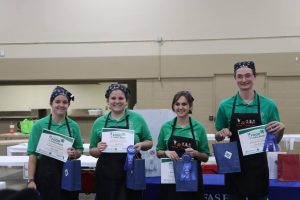
photo credit D. Clarke
O Crepe and the Spice Girls
With both Escambia teams representing the Northwest District at the state competition, it was exhilarating to watch the kids interact and quiz one another while awaiting the competition to begin. Seniors were given a red bell pepper as the mystery ingredient with the category of side dish and intermediates were given a tangerine for their mystery ingredient with the category of healthy dessert. Again, Escambia County dominated and secured first place in both age categories. The first-place senior team at the Florida State Fair, Escambia County’s O Crepe and the Spice Girls, is eligible to compete in the National 4-H Food Challenge at the State Fair of Texas in Dallas this fall.
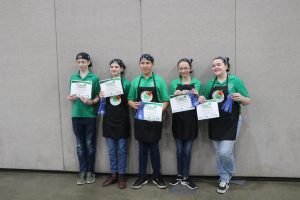
photo credit D. Clarke
Flaming Clovers
This new 4-H opportunity has been embraced in several counties thus far and will continue to grow. This project promotes practical life skills youth will use for the rest of their lives. If your child is interested in food and nutrition and/or healthy lifestyles projects, contact your local 4-H Agent to explore project opportunities.
A special thanks to Escambia County’s volunteer leader, Linda Crews, who has embraced this competition and has worked with these youth to truly make the best better, and to Mr. Dave Clarke for sharing state event photos.
For more information about the 4-H Food Challenge, visit our webpage. The 4-H Food Challenge would be a fun program for your next club meeting. Download the youth guide, team captain guide, and guide for hosting a food challenge.
by Heather Kent | Jul 28, 2022
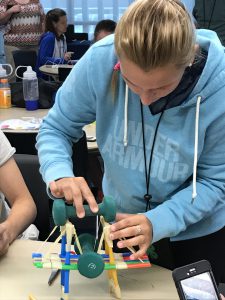 Whether you are a teen helping with a day camp, or an adult leading a club- it helps to have some tips and tricks in your back pocket to teach the content you want 4-H members to learn. 4-H volunteers and professionals often find themselves teaching a wide variety of audiences with different needs for learning. Trying to meet all those needs can sometimes seem overwhelming, but this week and next, our blog will focus on six specific strategies that will make this much easier- especially with practice! This blog post will discuss and give examples of three teaching strategies that can up your teaching and facilitation game- spacing, interleaving, and retrieval practice.
Whether you are a teen helping with a day camp, or an adult leading a club- it helps to have some tips and tricks in your back pocket to teach the content you want 4-H members to learn. 4-H volunteers and professionals often find themselves teaching a wide variety of audiences with different needs for learning. Trying to meet all those needs can sometimes seem overwhelming, but this week and next, our blog will focus on six specific strategies that will make this much easier- especially with practice! This blog post will discuss and give examples of three teaching strategies that can up your teaching and facilitation game- spacing, interleaving, and retrieval practice.
Why Bother? Isn’t the 4-H Curriculum “Good Enough?”
Some 4-H curricula have teaching strategies embedded within them. Some just have activities structured to help youth learn content. Learning and applying a few of these teaching strategies will make your teaching more interesting and engaging to a wider range of 4-H members. Engagement + interest = more fun for everyone!
Spacing
The term “spacing” simply means to spread learning out over time. When information is learned over the course of several weeks, months, or even years, youth (and adults) are more likely to retain that information than if it were dumped on them over several hours or days. This is why 4-H projects are so effective- youth often stay with the same project for one or more years, learning more complex information each year until they have mastered the content. Some project work even leads to future careers.
Here is an example of how you might apply spacing to the youth you work with in 4-H: One of the things youth want to do this year is participate in the Consumer Choices contest. Rather than teaching a marathon Saturday workshop the week before the contest, start early and introduce the concepts slowly either as part of a club meeting or an extra session before or after the regular club meeting time.
- Meeting #1- Explain why consumer skills are essential, what the topics for this year’s contest are, and the contest rules
- Meeting #2- Review cell phone plans and portable speakers (two of the topics). Demonstrate how to fill out a judging card and practice judging situations for cell phone plans and speakers.
- Meeting #3- Review ground transportation and smoothies (two more topics). Review how to fill out a judging card and practice judging situations.
- Meeting #4- Explain what oral reasons are- have an older youth demonstrate or what videos of youth giving oral reasons. Next, hold a mock contest and let youth practice giving oral reasons.
Interleaving (not to be confused with interweaving)
Interleaving means switching between topics. This allows youth opportunities to practice life skills in different situations. This helps reinforce the life skills that we teach in 4-H. For example, judging contest strategies are the same- it’s just the content that changes from contest to contest. Judging contests help youth learn about different topics, but the real value is they are learning how to think critically, communicate clearly, and work as a team. Applying those same skills to different subject matter helps youth learn lifelong skills (not just how to regurgitate facts). Here’s an example of interleaving that builds on the consumer choices example above:
The youth you work with will also want to learn about robotics, so you introduce an activity from the 4-H Junk Drawer Robotics curriculum. You divide the youth up into groups of three to complete a challenge to build a robot that draws. While teaching, refer back to what youth learned about critical thinking when they competed as a team in consumer choices. What did they learn about communication and teamwork? Ask them to apply those lessons to this situation when building a robot.
Retrieval Practice

4H youth work together in a drone course. Photo taken 10-15-18.
One of the best ways to strengthen your memory is to practice retrieving that information from your brain! Many of our 4-H curricula include games that allow youth to practice information retrieval. Quiz bowls and skill-a-thon stations are two great ways to incorporate retrieval practice. Here is an example of retrieval practice that builds upon the consumer choices example:
Youth enjoyed participating in the consumer choices contest and asked if they could do more activities like that. Your local 4-H agent suggested a program called “Living on My Own” which is a financial simulation that helps teach financial literacy skills. As the youth rotate through the stations, they retrieved and practiced some of the consumer skills they learned earlier as they decided on housing, transportation, food, and other items based on their simulated salary and living situation. Being about to recall and practice these skills helps reinforce financial literacy.
One of the best things about 4-H is it is learner-centered. That means that youth can choose what they want to do and learn in 4-H. Your local 4-H Extension Office can help you find the best curriculum to support your youths’ learning needs, but the curriculum is only part of learning. 4-H supports learning (usually referred to as a project) through a variety of competitive and non-competitive events. The three strategies described in this post can help volunteers and 4-H professionals link learning between projects and activities. Next week’s post will explore three more strategies for teaching youth- elaboration, concrete examples, and duel coding.
References:
- Potter, S. (2021). Educational Design and Delivery – Utilization of Multiple Teaching Strategies. 4-H VKRC Fact Sheets.
- Weinstein, Y., Madan, C. R., & Sumeracki, M. A. (2018). Teaching the science of learning. Cognitive Research: Principles and Implications, 3, 2. https://cognitiveresearchjournal.springeropen.com/articles/10.1186/s41235-017-0087-y
- Weinstein, Y, Sumeracki, M & Caviglioli, O (2019) Understanding how we learn: A visual guide. Routledge, Abingdon, Oxon, UK.
















